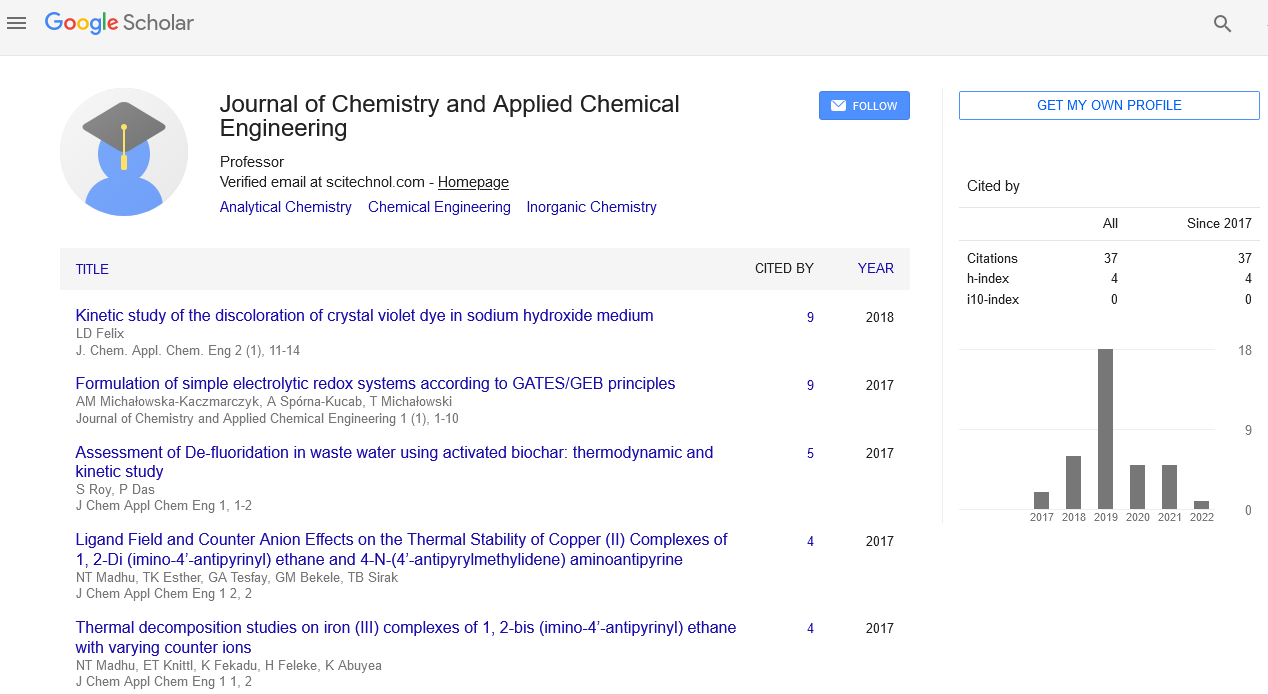Perspective, J Chem Appl Chem Eng Vol: 7 Issue: 1
Modeling and Simulation of Chemical Reaction Kinetics and Transport Phenomena
Karakaya Y*
1Department of Thermodynamics, University of Duisburg, Duisburg, Germany
*Corresponding Author: Karakaya Y
Department of Thermodynamics, University
of Duisburg, Duisburg, Germany
E-mail: kar@akaya.edu.de
Received date: 01 March, 2023, Manuscript No. JCACE-23-93042;
Editor assigned date: 03 March, 2023, Pre QC No. JCACE23-93042(PQ);
Reviewed date: 17 March, 2023, QC No. JCACE-23-93042;
Revised date: 24 March, 2023, Manuscript No. JCACE-23-93042(R);
Published date: 31 March, 2023, DOI: 10.4172/Jcace.1000e015
Citation: Karakaya Y (2023) Modeling and Simulation of Chemical Reaction Kinetics and Transport. J Chem Appl Chem Eng 7:1.
Description
Modeling of chemical reaction kinetics and transport phenomena is a area of research in chemical engineering and related fields. It involves the development of mathematical models that describe the behavior of chemical reactions and the transport of substances in different media, such as gases, liquids, and solids. These models can be used to design and optimize chemical processes, understand the underlying mechanisms of complex chemical reactions, and predict the behavior of chemical systems under different conditions [1].
Transport phenomena, on the other hand, refers to the movement of substances in different media, such as the diffusion of a gas in a liquid or the transport of heat in a solid. The modeling of transport phenomena involves developing mathematical models that describe the behavior of these processes [2]. These models are typically based on fundamental principles of physics and can be used to simulate and predict the behavior of transport processes under different conditions.
In order to develop accurate models of chemical reaction kinetics and transport phenomena, it is necessary to have a thorough understanding of the underlying chemical and physical processes. This requires a combination of experimental data and theoretical knowledge [3]. For example, experimental data can be used to determine the rate of a chemical reaction under different conditions, while theoretical knowledge can be used to develop a kinetic model that describes the reaction mechanism and the behavior of the substances involved [4].
Once a model of chemical reaction kinetics and transport phenomena has been developed, it can be used to design and optimize chemical processes. For example, the model can be used to predict the behavior of a chemical reaction under different conditions, allowing engineers to design a process that operates efficiently and produces the desired products. The model can also be used to optimize the conditions of a process, such as the temperature and pressure [5].
The modeling of chemical reaction kinetics and transport phenomena is an important area of research in chemical engineering and related fields [6]. The development of accurate models can be used to design and optimize chemical processes, understand the underlying mechanisms of complex chemical reactions, and predict the behavior of chemical systems under different conditions. With continued research and development, these models have the potential to improve the efficiency, safety, and environmental impact of chemical processes [7].
There are several methods for simulating chemical reactions and transport phenomena. One approach is to use Computational Fluid Dynamics (CFD) simulations, which use numerical methods to solve the equations that govern fluid motion and transport of substances [8]. Another approach is to use kinetic models, which describe the rate of chemical reactions and the behavior of the substances involved in the reaction [9].
In order to perform simulations of chemical reactions and transport phenomena, it is necessary to have accurate models of the chemical kinetics and transport properties of the substances involved. This requires a thorough understanding of the underlying chemical and physical processes, as well as experimental data to validate the models [10].
Conclusion
The simulation of chemical reactions and transport phenomena is an important tool in many fields, including chemical engineering, materials science, environmental science, and biotechnology. It allows researchers and engineers to design and optimize processes with improved efficiency, reduced environmental impact, and increased safety.
References
- Zarra S, Wood MD, 2015 Derrick A, Roberts AD, Nitschke JR Molecular containers in complex chemical systems. Chem Soc Rev 44(2): 419-432.
[Google Scholar] [Pudmed]
- Gilliland ER, 1934 Diffusion coefficients in gaseous systems. Ind Eng Chem 26(6): 681-685.
- Berger RJ, Stitt EH, Marin GB, Kapteijn F, Moulijn JA 2001 Eurokin. Chemical reaction kinetics in practice. Cattech 5(1): 36-60.
- Noam A, 1995 The grotthuss mechanism. Chem Phys Lett 244(5-6): 456-462.
- Rana A, Millero 1973 Compressibility of water as a function of temperature and pressure. J Chem Phys 59(10): 5529-5536.
- Lewis D, Na4379 G 1968 Flame structure and flame reaction kinetics II. Transport phenomena in multicomponent systems. Proc R Soc Lond B Biol Sci. Series A. 307(1488): 111-135.
- Felder RM, Rousseau RW, Bullard LG 2020 Elementary principles of chemical processes. John Wiley & Sons 18(23): 480.
- Wendt JF 1995 Computational fluid dynamics. 206
- Fukui K, 1981 The path of chemical reactions-the IRC approach. Acc Chem Res 14(12): 363-368.
- Bartolo P, Kruth JP, Silva J, Levy G, Malshe A et al., (2012) Biomedical production of implants by additive electro-chemical and physical processes. CIRP annals 61(2): 635-655.
 Spanish
Spanish  Chinese
Chinese  Russian
Russian  German
German  French
French  Japanese
Japanese  Portuguese
Portuguese  Hindi
Hindi 